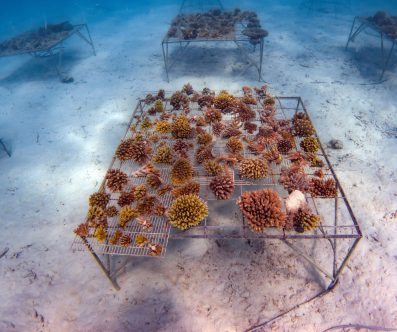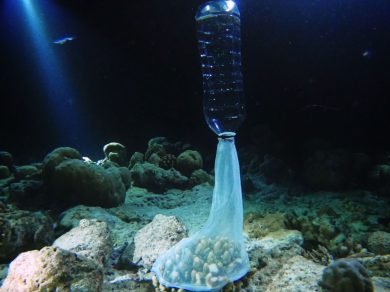Our methods

Mineral Accretion Technology (MAT)
Mineral Accretion Technology (MAT) uses low-voltage electric currents to stimulate coral growth on metal structures placed underwater. When the current passes through these structures, it encourages a natural buildup of calcium carbonate, which corals use to form their skeletons. This accelerated buildup allows corals to grow faster and form stronger structures that are more resilient to environmental stressors. By fostering faster growth and stronger foundations, MAT contributes to more robust and enduring coral reefs that can continue to support rich biodiversity.
Table Nurseries
Table nurseries are underwater structures designed to nurture coral fragments in a stable, controlled environment. These tables keep young corals elevated off the seabed, protecting them from predators, sedimentation, and strong currents, allowing them to grow under optimal conditions. After several months, when the corals have matured, we either transplant individual colonies onto the reef to restore damaged areas or, in some cases, move entire coral-covered tables directly to the reef.


Rope Nurseries
In rope nurseries, coral fragments are attached to ropes that float or are anchored underwater. This setup allows corals to grow around the entire rope, benefiting from full 360-degree exposure to sunlight and water movement, which supports healthy and rapid development. Rope nurseries are highly efficient, requiring minimal materials, making them a simple yet effective tool for coral restoration. Once the corals have matured, we collect individual colonies and transplant them to areas of the reef that need regeneration.
Substrate Stabilization
To counter sediment buildup and erosion, we place wire mesh over unstable ocean floors, providing a stable foundation for coral growth. The wire mesh acts as a framework for corals and other marine organisms to settle and attach, creating a protected space free from the shifting sands and strong wave action that can hinder coral development. This stabilization method helps maintain reef health by creating secure areas for coral recruitment, allowing young corals to thrive and gradually restore degraded sections of the reef.


Shoreline Barriers
Microfragmentation
Microfragmentation is a technique where coral colonies are divided into tiny fragments, which grow rapidly when spaced closely together. This method significantly speeds up coral growth and allows for mass propagation. Once mature, these fragments are transferred to the reef to help restore damaged areas and support ecosystem recovery.


Sexual Reproduction
Mangrove Planting
Mangroves are powerful natural protectors of coastlines and nearby reefs. By planting mangrove seedlings, we create a living buffer that stabilizes the soil, filters pollutants from coastal runoff, and provides essential nursery habitat for fish and marine life. The dense mangrove roots help trap sediments, keeping the waters clear for corals and reducing coastal erosion. As they grow, mangroves contribute to a healthier marine ecosystem, protect coastal communities, and enhance the resilience of coral reefs by acting as a natural shield against storms and high waves.

